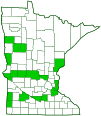spotted white-cheeked jumping spider
(Pelegrina insignis)
Conservation • Description • Habitat • Biology • Distribution • Taxonomy
Conservation Status |
|
|||||||
| IUCN Red List | not listed |
|||||||
| NatureServe | NNR - Unranked SNR - Unranked |
|||||||
| Minnesota | not listed |
|||||||
Description |
||
Spotted white-cheeked jumping spider is a small jumping spider. It is widespread across the northern tier of the United States east of the Rocky Mountains and in southern Canada. It is common in Minnesota. The male is ⅛″ (3.4.5 to 4.1 mm) long not including the legs. The female is a little larger, ⅛″ to 3 ⁄16″ (3.8 to 5.3 mm) long. The plate covering the cephalothorax (carapace) is dark brown. There are four pairs of eyes arranged in what appears to be three rows occupying less than half of the carapace. The first row of four eyes, consisting of the anterior median eyes (AME) and anterior lateral eyes (ALE), is curved backward. The AME are the middle and forward-most pair of these. They are by far the largest of all of the eyes and can be moved. The AME are about twice as large as the ALE. The second row of two eyes are the posterior median eyes (PME). They are very small and are barely or not at all noticeable on most photos. The third row of eyes is the posterior lateral eyes (PLE). The PLE are set far back on the head and are only slightly wider apart than the first row of four eyes (AME and ALE together). The PME and ALE form a wide rectangle. Just behind each AME there is a pale stripe which, taken together, form a distinct V shape. A longitudinal band of pale scales on each side begins beside the ALE, passes below the AME and PME, and extends to the thorax. There is also a pale lower marginal band on each side of the carapace. On the side of the face there is a weak oblique pale band. On the female the carapace is densely covered with yellowish-white scales, and none of these bands are distinct. The plate on the face above the mouth (clypeus) is narrow and brown. The finger-like sensory organs attached to the front of the cephalothorax (pedipalps) are yellowish. The abdomen is brown, is ringed with white bands, and has pale spots on the sides. In the middle of the upper (dorsal) side there are six pairs of pale spots. On the female there are also paired black spots. The legs are short, oriented forward, and adapted for jumping. On the male they have alternating brown and pale areas but these do not form distinct bands. On the female they are entirely yellowish. |
||
Size |
||
Female Body Length: ⅛″ to 3 ⁄16″ (3.8 to 5.3 mm) Male Body Length: ⅛″ (3.4 to 4.1 mm) |
||
Web |
||
|
||
Similar Species |
||
Habitat |
||
Prairies and old fields Spotted white-cheeked jumping spider is found mostly on short shrubs (less than 20″ tall) among grasses. |
||
Biology |
||
Season |
||
|
||
Behavior |
||
|
||
Life Cycle |
||
|
||
Food |
||
|
||
Distribution |
||||
|
Sources Conservation Biology of Special Concern Jumping Spiders (Araneae: Salticidae) of Minnesota; Ehmann, William J. Ehmann; 12/2/2002. |
|||
| 5/25/2022 | ||||
Occurrence |
||||
Common A survey of jumping spiders in Minnesota was conducted in 1999 and 2001. 572 specimens were collected at 117 sites in 20 counties. With 97 specimens collected, spotted white-cheeked jumping spider was the second most common species. |
||||
Taxonomy |
|||
| Class | Arachnida (Arachnids) | ||
Order |
Araneae (Spiders) | ||
Suborder |
Araneomorphae (Typical Spiders) | ||
| Infraorder | Entelegynae | ||
Superfamily |
Salticoidea | ||
Family |
Salticidae (jumping spiders) | ||
Subfamily |
Salticinae (typical jumping spiders) | ||
Tribe |
Dendryphantini | ||
| Subtribe | Dendryphantina | ||
| Genus | Pelegrina (white-cheeked jumping spiderI | ||
All jumping spiders, including those in the genus Pelegrina, were formerly place in the genus Metaphidippus. |
|||
Synonyms |
|||
|
|||
Common Names |
|||
spotted white-cheeked jumping spider |
|||
Glossary
Carapace
The hard, upper (dorsal), shell-like covering (exoskeleton) of the body or at least the thorax of many arthropods and of turtles and tortoises. On crustaceans, it covers the cephalothorax. On spiders, the top of the cephalothorax made from a series of fused sclerites.
Cephalothorax
The front part of a spider’s body, composed of the head region and the thoracic area fused together. Eyes, legs, and antennae are attached to this part.
Clypeus
On insects, a hardened plate on the face above the upper lip (labrum).
Palp
Short for pedipalp. A segmented, finger-like process of an arthropod; one is attached to each maxilla and two are attached to the labium. They function as sense organs in spiders and insects, and as weapons in scorpions. Plural: palpi or palps.
Tibia
The fourth segment of an insect leg, after the femur and before the tarsus (foot). The fifth segment of a spider leg or palp. Plural: tibiae.
Visitor Photos |
|||||
Share your photo of this arachnid. |
|||||
| This button not working for you? Simply email us at info@MinnesotaSeasons.com. Attach one or more photos and, if you like, a caption. |
|||||
Alfredo Colon |
|||||
 |
 |
||||
 |
 |
||||
 |
|||||
MinnesotaSeasons.com Photos |
|||||

Slideshows |
||

Visitor Videos |
|||
Share your video of this insect. |
|||
| This button not working for you? Simply email us at info@MinnesotaSeasons.com. Attach a video, a YouTube link, or a cloud storage link. |
|||
Other Videos |
|||

Created: 7/23/2019
Last Updated:


